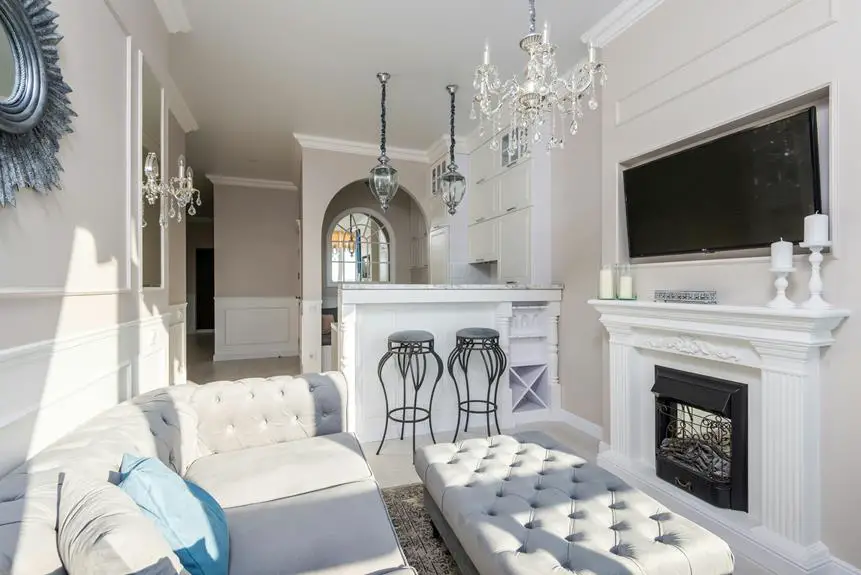When you think about improving a room's acoustics, you might not immediately consider the role of fabric. Yet, chenille can be surprisingly effective in this regard. Its unique texture and density allow it to absorb sound, reducing both echo and reverberation. By incorporating chenille through upholstery or rugs, you can transform not just the sound but also the overall ambiance of the space. What you might find surprising, however, is how these acoustical benefits tie into your interior design choices and everyday comforts.
Table of Contents
Properties of Chenille Fabric
Understanding the properties of chenille fabric reveals its unique softness and durability, making it a popular choice for home furnishings. When you touch chenille, you instantly appreciate its plush texture, which adds warmth to any space. This softness comes from the unique yarn structure, where a raised pile creates a velvety surface that's inviting to both the eye and the hand.
Chenille's durability is another significant factor. Its tightly woven fibers resist fraying and fading, allowing it to withstand the rigors of daily use. This makes chenille a great option for furniture upholstery, especially in high-traffic areas where wear and tear can occur.
You'll also find that chenille is available in a variety of colors and patterns, giving you ample opportunity to express your personal style. Whether you prefer vibrant hues or subtle tones, there's a chenille fabric that fits your aesthetic needs. In addition to its practical qualities, the fabric offers a luxurious look that enhances your room's overall design. With both comfort and resilience, chenille proves to be a smart choice for transforming your living space into a cozy, stylish sanctuary.
Sound Absorption Capabilities
When you think about sound absorption in a room, the fiber density of chenille fabric plays a crucial role.
The unique surface texture also contributes significantly to how effectively it can reduce noise.
Let's explore how these factors work together to enhance acoustics in your space.
Fiber Density Impact
Fiber density significantly influences sound absorption capabilities, enhancing how effectively a room can manage noise levels. When you choose chenille fabric with higher fiber density, you're investing in a material that can trap and reduce sound waves more efficiently. This reduction in sound reflections creates a quieter and more comfortable environment.
Higher fiber density means more tightly packed fibers, which leads to better sound absorption. Think of it like a sponge soaking up water; the denser the sponge, the more liquid it can absorb. Similarly, dense chenille can capture more sound energy, diminishing echoes and background noise.
In practical terms, if you're looking to improve acoustics in areas like a home theater, music room, or recording studio, opting for chenille with greater fiber density can make a noticeable difference. You'll enjoy clearer sound and less distraction from external noise.
On the other hand, if you choose low-density fibers, you risk increased sound reflections that could lead to a harsher auditory experience. Therefore, pay attention to fiber density in chenille when considering your room's acoustics. You'll significantly enhance the cozy ambiance you're aiming for.
Surface Texture Benefits
The unique surface texture of chenille not only adds visual appeal but also enhances its sound absorption capabilities, making your space quieter and more enjoyable.
When you choose chenille fabrics, you're opting for a material that has a soft, tactile quality that absorbs sound rather than reflecting it. This texture acts as a barrier against noise, allowing you to create a serene environment.
Incorporating chenille into your décor—whether through upholstery, cushions, or drapery—can significantly reduce echoes and background noise.
The thicker, plush fibers trap sound waves, reducing the overall noise level in your room. If you're looking to create a home theater or a cozy reading nook, adding chenille elements can be particularly effective.
Furthermore, chenille's unique design enables it to dampen heavy sounds that can disrupt your peace.
This is especially beneficial in open-concept spaces where noise can easily travel. Remember, the more textured the surface, the better it can absorb sound.
Reducing Echo and Reverberation
Echo and reverberation can be significantly reduced by incorporating chenille fabrics into your room's design, as they absorb sound waves effectively.
When you choose chenille for upholstery, curtains, or cushions, you're making a smart acoustic choice. The soft, plush texture of chenille traps sound, preventing it from bouncing off hard surfaces, which minimizes annoying echoes and reverberation.
If you've ever experienced that overwhelming bounce-back of sound in a room, you'll appreciate how crucial it's to manage acoustics. Hard floors and bare walls often amplify noises, creating discomfort. By adding chenille elements, you create a more intimate sound environment that feels inviting and peaceful.
In spaces like offices or homes where clear communication is essential, using chenille can enhance the overall experience. You'll notice that conversations flow better, and the atmosphere becomes much more relaxed.
Even within entertainment areas, chenille can help maintain sound clarity, making movie nights or music sessions more enjoyable.
Incorporating these soft fabrics is a practical solution to combat unwanted noise. By optimizing your room's acoustics with chenille, you're transforming your space into a quieter, more comfortable haven.
Enhancing Room Aesthetics and Acoustics
Sculpting your space with chenille not only elevates its visual appeal but also significantly enhances its acoustic properties.
The rich, textured fabric of chenille adds depth and warmth, creating an inviting atmosphere. When you incorporate it into your décor, whether through cushions, drapes, or upholstery, you're not just making a style statement; you're also making a smart choice for sound absorption.
Chenille's unique fibers effectively trap sound waves, reducing noise levels while adding a cozy feel to the room.
This dual functionality allows you to achieve a tranquil environment, perfect for relaxation or focused work. If you want to amplify your design, consider layering different chenille items to create a harmonious, cohesive look that also serves to soften sound.
Practical Applications in Interior Design
Incorporating chenille into your interior design can transform spaces while providing practical benefits, such as improved sound absorption and enhanced comfort. You'll find that using chenille pieces, like cushions or throws, can significantly dampen noise levels, making your home feel cozier and more inviting.
Think about using chenille upholstery for sofas and chairs to create a relaxing environment. The soft texture not only adds warmth but also absorbs sound, which is especially beneficial in open-concept spaces where sound can echo.
You might also consider layering chenille rugs on hard floors. These rugs soften both footfalls and auditory distractions, making for a peaceful atmosphere.
When decorating your bedroom, choosing a chenille bedspread or quilt enhances the comfort level while also controlling sound reverberation, promoting a restful night's sleep.
In dining areas, incorporating chenille seat cushions can make mealtime more enjoyable. All these practical applications improve both the acoustics and aesthetic appeal of your spaces.
Choosing the Right Chenille Products
When selecting chenille products, you'll want to consider fabric density as it plays a crucial role in sound absorption.
The texture also affects how sound interacts within your space, so pay attention to that.
Fabric Density Impact
Choosing the right chenille products hinges on understanding how fabric density affects sound absorption and overall room acoustics. When you dive into selecting chenille for your space, pay close attention to the density of the fabric. Denser materials generally offer better sound absorption properties. This means they can significantly minimize echoes and reduce noise pollution in your environment.
For instance, heavy chenille upholstery on furniture can help dampen sounds generated in your room, creating a more pleasant auditory experience. If you're looking to minimize distractions, opting for thicker, denser chenille in your curtains or cushions can make a noticeable difference.
Additionally, think about the strategic placement of these dense chenille items. Adding them in areas where sound tends to bounce, like corners or near hard surfaces, enhances their effectiveness. You'll notice that these carefully chosen pieces not only elevate your decor but also transform your room into a more serene environment.
Ultimately, understanding the link between fabric density and acoustics can guide you in picking the right chenille. Embrace this knowledge to create a harmonious balance between aesthetics and sound quality in your space.
Texture and Sound Absorption
The texture of chenille plays a crucial role in its sound absorption abilities, influencing how effectively it can dampen noise in your space. When you're selecting chenille products, consider the texture to maximize their acoustic benefits.
Thickness: Thicker chenille fabrics tend to absorb sound better than thinner ones.
Weave Pattern: A tighter weave can minimize sound penetration, while a looser weave may allow more sound to pass through.
Pile Height: Longer piles can trap more sound waves compared to shorter ones, enhancing quietness in the room.
Color and Finish: While aesthetics are important, some finishes can impact how sound interacts with the fabric.
Placement Strategies Matter
To maximize the acoustic benefits of chenille, strategic placement of the fabric in your space can significantly enhance sound absorption and overall comfort. Start by considering where sound tends to bounce. Place chenille products like cushions or curtains on hard surfaces—think walls and floors—to intercept noise before it travels.
When decorating your room, opt for thicker chenille fabrics for areas you want to soundproof, such as home theaters or music rooms. Floor-to-ceiling chenille curtains not only provide a dramatic aesthetic but also absorb sound effectively. Additionally, scatter smaller chenille items like throw pillows across sofas and chairs to dampen noise in more open spaces.
Don't overlook area rugs; a plush, chenille rug can dramatically reduce echoes while adding warmth to your decor. Arrange rugs to cover high-traffic areas, where noise is often more pronounced.
Lastly, balance your chenille fabrics with other sound-absorbing materials, like upholstered furniture or acoustic panels, for a well-rounded approach to room acoustics. By thoughtfully placing chenille products, you'll enhance both the look and sound quality of your home.
Frequently Asked Questions
Is Chenille Suitable for All Room Types in Terms of Acoustics?
Chenille's soft texture absorbs sound, making it suitable for various room types. While it works well in living rooms and bedrooms, consider your space's overall design and function to ensure it meets your specific acoustic needs.
How Does Chenille Compare to Other Acoustic Fabrics?
When comparing chenille to other acoustic fabrics, you'll notice its unique texture effectively absorbs sound while adding warmth. Unlike smoother fabrics, it provides better noise reduction, making your space feel cozier and quieter overall.
Can Chenille Help With Soundproofing a Room Effectively?
Yes, chenille can help soundproof a room effectively. Its thick, plush texture absorbs sound better than many other fabrics, reducing echoes and noise levels, making your space more comfortable and quieter for your enjoyment.
What Maintenance Is Required for Chenille to Retain Acoustic Benefits?
To maintain chenille's acoustic benefits, you'll want to regularly vacuum it to avoid dust buildup, rotate cushions to distribute wear, and spot clean any stains to preserve its texture and sound-dampening qualities.
Are There Eco-Friendly Chenille Options Available for Acoustics?
Absolutely, you'll find eco-friendly chenille options that use sustainable fibers and dyes. Look for brands committed to environmentally-conscious practices, ensuring you can enhance both acoustics and sustainability in your living spaces while making a positive impact.
- How Does Ring Spun Cotton Affect Garment Fit and Shape Retention? - August 13, 2024
- What Are the Challenges in Producing Ring Spun Cotton? - August 13, 2024
- Is Ring Spun Cotton Suitable for Plus-Size Clothing? - August 13, 2024







